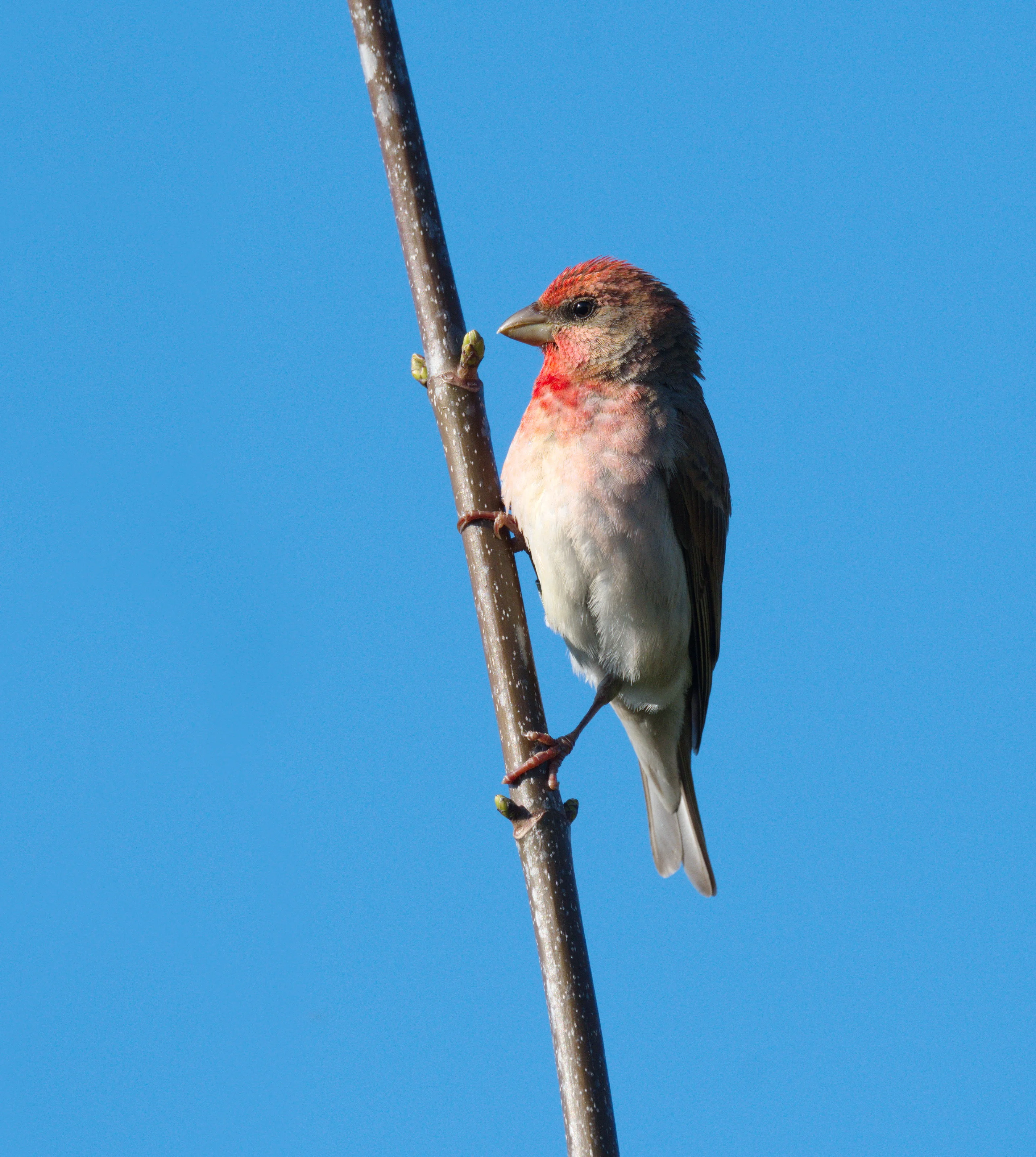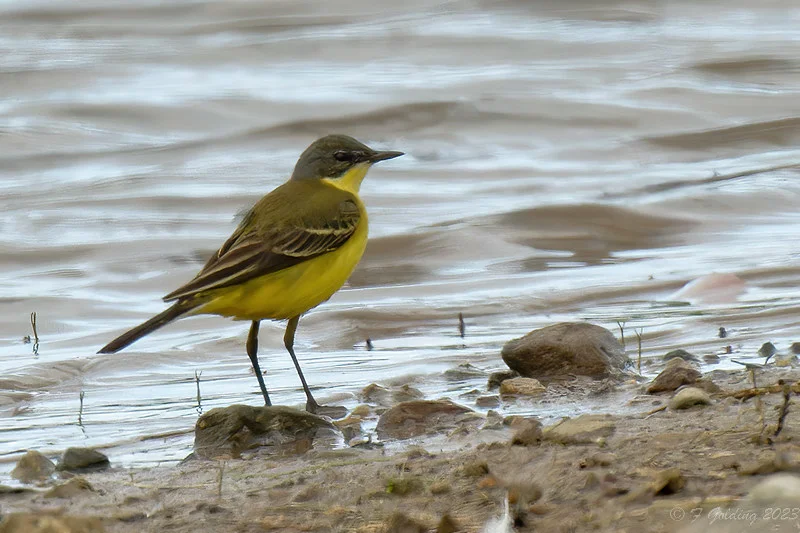By the time June rolls around in the British birding calendar, migration begins to tail off and imaginations can dream of mega-rare visitors from all points of the compass. June is often one of the most productive months of the year in this regard, after all, including no fewer than six firsts for Britain and Ireland since 2020 alone.
As it transpired, Scotland would dominate the nation’s airwaves this week, with Shetland in particular cashing in on the action. Top of the billing was a gorgeous Blue-cheeked Bee-eater on Foula on 10th. Unfortunately it disappeared soon after discovery, although many will be hopeful of a reappearance elsewhere in the island chain. Shetland’s only previous record consisted of one for 14 days in June-July 1997. A report of a bee-eater at Sandness, Mainland, the previous day appears likely to relate to the same bird.

Blue-cheeked Bee-eater, Foula, Shetland (Geoff Atherton).
Britain’s first Eastern Olivaceous Warbler since 2019 was at Quendale, Mainland, from 9-11th. Shetland enjoys a remarkable affinity with the taxon in a British context, hosting 11 of 23 birds on record. Another exciting addition to the archipelago’s avifauna was a display-flighting adult Broad-billed Sandpiper near Levenwick, Mainland, from 4th, back for a second year in succession.

Eastern Olivaceous Warbler, Quendale, Mainland, Shetland (Chris Griffin).
In recent years, Collared Flycatchers have become a rare but regular fixture in the Northern Isles in late spring, despite retaining their immense rarity status elsewhere. This week, a female trapped and ringed on North Ronaldsay on 7-8th was followed up by a simply stunning male ranging along the Fair Isle clifftops on 9th.

Collared Flycatcher, Fair Isle, Shetland (David Parnaby).
On the Scottish mainland, a singing adult White-crowned Sparrow at Girdle Ness, Aberdeenshire, on 11th caused some panic. Continuing Britain’s excellent run of Nearctic sparrows this spring, it was found immediately adjacent to the city’s international port and remained mobile until nightfall. Dark lores and a large, pinkish bill identify it as a bird belonging to the nominate leucophrys subspecies, the most common race breeding from Newfoundland and Labrador across to the Northwest Territories. It is also the second subspecies to be recorded in Britain this spring, after an adult gambelii at Seaford Head, East Sussex, back in April. Rounding off a brilliant week for Scottish birders was a dark-morph Eleonora’s Falcon south over North Berwick, Lothian, on 9th. If accepted, it will become just the second for Scotland after one on the Outer Hebrides in 1985.

White-crowned Sparrow, Girdle Ness, Aberdeenshire (Andrew Whitehouse).
Over in Ireland, news emerged of the adult male Least Tern returning for a third summer, seen at Little Tern colonies at both Portrane, Co Dublin, and Baltray, Co Louth. Last year it remained in the area until mid-August and plenty will hoping for a repeat feat this time around – even more still will be hoping it might put in an appearance on the west coast of Britain. One species cavorting on both sides of the Irish Sea was Gull-billed Tern. One was at Ring, Co Cork, on 5th, followed by reports from the Loughor Estuary on the Glamorgan/Carmarthen border on 7th and Tacumshin, Co Wexford, on 8-9th. Do all three reports concern the same wandering individual?
A few record shots of the Least Tern at Baltray, Co. Louth this evening. Bird appeared briefly at Portrane colony this morning before being refound later here by @1squidge. Calling quite a bit, but elusive at times, it landed in the colony once but was chased off. @LouthBirdNews pic.twitter.com/zZv8pVU2dk
— Aidan G. Kelly (@agk10k) June 11, 2023
The third Caspian Tern for Baston and Langtoft Pits, Lincolnshire, in just six years arrived on 8th, relocating to Northstowe, Cambridgeshire, the following day. Amazingly, the species is an altogether rarer beast on that side of the county line, where it became the first Cambridgeshire record since 1991! One more was on the Tees Marshes, Cleveland, on 11th. Elsewhere, the American Black Tern remained a reliable visitor to Long Nanny, Northumberland, and it was another decent week in eastern and central areas for Black Terns of the European variety. A first-summer Baltic Gull was at Widnes, Cheshire, on 11th.

Caspian Tern, Baston & Langtoft Pits, Lincolnshire (Josh Jones).

American Black Tern, Long Nanny, Northumberland (Ted Smith).
A Savi’s Warbler sang at Leven Carrs, East Yorkshire, late on 7th, with another at Budleigh Salterton, Devon, from 1-3rd. Cleveland was the latest county to add Great Reed Warbler to its 2023 totaliser, with one at Saltholme RSPB. Others remained in Norfolk and Somerset. Shetland boasted the bulk of the week’s Blyth’s Reed Warblers reports with four, joined by one on the Outer Hebrides. Marsh Warblers, meanwhile, enjoyed an excellent week, with in excess of 25 reported. This included popular inland finds in Cambridgeshire and Leicestershire.


Blyth’s Reed Warbler (top) and Marsh Warbler (bottom), Fair Isle, Shetland (Georgia Platt).
A surprise male Ortolan Bunting on Papa Stour, Shetland, on 7th had some pondering for something much rarer, considering we are now into the peak ‘mega-rarity window’ of mid-June, although photographs confirmed the suggested identification. Additional Shetland visitors included a Red-breasted Flycatcher on Fetlar and a Red-rumped Swallow at Lunna, Mainland. Out Skerries scored a Greenish Warbler on 9th, while 6th brought a singing male Eastern Subalpine Warbler to Boulby, Cleveland. Even more surprising was an Arctic Warbler sound recorded at Berrow, Somerset, on 5th! A vocal male Icterine Warbler at Conwy RSPB on 7th came as a shock to North Walian birders, with a couple more at Spurn.

Eastern Subalpine Warbler, Boulby, Cleveland (Bob Howe).

Common Rosefinch, Kendal, Cumbria (Carolyn Farry).
Other scarce migrant totals consisted of a couple of Wrynecks in Shetland, two Hoopoes, three Common Rosefinches, six Rosy Starlings, up to six European Bee-eaters, seven Grey-headed Wagtails, 10 Golden Orioles, 18 Red-backed Shrikes and four European Serins – including, most notably, one at Pennington Flash, Greater Manchester. A Woodchat Shrike at Easington, East Yorkshire, on 11th was another noted arrival. Two Bluethroats comprised the usual White-spotted in Gloucestershire and a female on Isle of May, Fife.

Red-backed Shrike, Spurn YWT, East Yorkshire (Ian Howard).

Grey-headed Wagtail, Maiden’s Hall Lake, Northumberland (Frank Golding).
Red-footed Falcons were in Nottinghamshire and Essex, with Montagu’s Harriers in Essex, Norfolk and Lincolnshire, and a Black Kite again in Cornwall.
Notable breaking news this week concerned the successful hatching of no fewer than four Black-winged Stilt chicks at Frampton Marsh RSPB, becoming the first breeding record for Lincolnshire. Other publicised birds included new finds in Cambridgeshire, Cheshire, Greater Manchester and Conwy.

Black-winged Stilt, Frampton Marsh RSPB, Lincolnshire (David Carr).
On 5th, a first-summer Spotted Sandpiper at Upton Warren NR attracted a crowd, followed by a Lesser Yellowlegs at Manby Flashes, Lincolnshire, on 8th and a White-rumped Sandpiper inland at Hatfield Moors, South Yorkshire, on 11th. Pectoral Sandpipers were in Northumberland, Aberdeenshire and Co Donegal, with migrant Red-necked Phalaropes in Dorset and Aberdeenshire.

Lesser Yellowlegs, Manby, Lincolnshire (Mark Johnson).

Red-necked Phalarope, Ferrybridge, Dorset (John Wall).
The Cambridgeshire Ouse Washes played host to a remarkable conglomeration of herons and storks this week, the kind unimaginable just 10 years ago. The Mediterranean mixture comprised a Purple Heron, four Black-crowned Night Herons, White Stork, two Glossy Ibises, Eurasian Spoonbill, four Western Cattle Egrets and at least two Great Egrets! An additional seven Black-crowned Night Herons were in Britain and Ireland and five more sites between Scilly and Norfolk enjoyed Purple Herons. Notable news from Warwickshire concerned a returning adult male Little Bittern at Ladywalk NR for a second year running, although access is restricted to West Midland Bird Club members only.

Black-crowned Night Heron, Ouse Washes RSPB, Cambridgeshire (D Benton).

Purple Heron, Summer Leys LNR, Northamptonshire (Rik Addison).
The reappearance of the drake Hooded Merganser at Whinfell Tarn, Cumbria, on 8th came as quite a surprise after a three-week absence and will have undoubtedly led to some gnashing of teeth – lingering so far into the summer months won’t do it any favours with the rarity committees. The week’s wildfowl highlight comprised a drake Blue-winged Teal at Fen Drayton Lakes RSPB, Cambridgeshire, on 10-11th – the first in the county since 2013.

Blue-winged Teal, Fen Drayton Lakes RSPB, Cambridgeshire (Matthew Mellor).
A Lesser Scaup was in Caithness and Ferruginous Ducks were at Hickling Broad, Norfolk, and Colwick CP, Nottinghamshire. Additional action included an American Wigeon on Tiree, Argyll, the American Black Duck still in Co Mayo, three Green-winged Teal and five Ring-necked Ducks. A Taiga Bean Goose was still on Lewis, Outer Hebrides, until 7th; four White-billed Divers were off the north coast of Scotland.

Ferruginous Duck, Colwick CP, Nottinghamshire (Miles Cluff).
Western Palearctic
A non-stop run of raptors on the Near Continent in northern France, Belgium and The Netherlands had British birders salivating at the possibility of one or two making the crossing during favourable conditions over the next few weeks. Griffon Vultures in particular were found en-masse, including a mammoth 50 over Mont-Saint-Michel, Normandy, and 24 over Heuvelland, Belgium. The Netherlands’s fifth Eastern Imperial Eagle over Scherpenzeel on 10th was a major discovery, with other sightings of note comprising a Lesser Spotted Eagle, three Booted Eagles and two Bearded Vultures.
Iceland’s second Stejneger’s Scoter was a welcome treat off Selvik from 9th, present in the same flock as two female White-winged/Stejneger’s Scoter. The French-ringed first-summer Bonelli’s Eagle continued to tour Sweden, resurfacing in the far south of the country near Tomelilla on 9th. A Blue-cheeked Bee-eater – noticeably different to the Shetland bird – was at Kajaani, Finland, on 5th, with a Steppe Eagle over Skagen, Sweden.
A Trumpeter Finch was at Marienhafe, Germany, while a Green Warbler on Heligoland was the country’s fifth. Headline news in Poland saw the remarkable discovery of a Semipalmated Plover at Vistula Lagoon on 2nd – a national first. The country’s eighth Green-winged Teal was at Babin too, while Belarus bagged a Griffon Vulture at Vyhadsty.
The Ancient Murrelet continued at Huelva, Spain, for another week and a Western Reef Heron was in Catalonia, while a Semipalmated Plover and Lesser Yellowlegs were on Terceira, Azores. Belated news concerned the first Intermediate Egret for Algeria at Djanet on 12 May.














